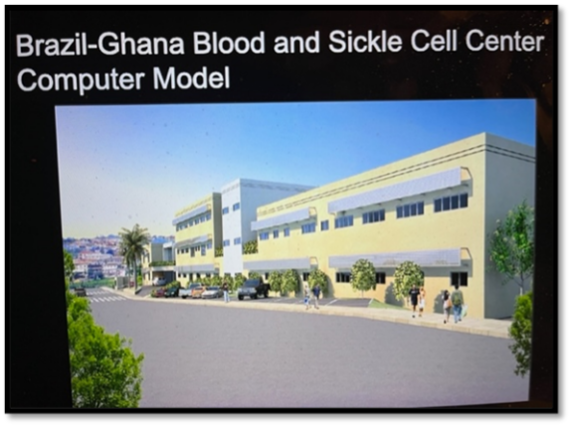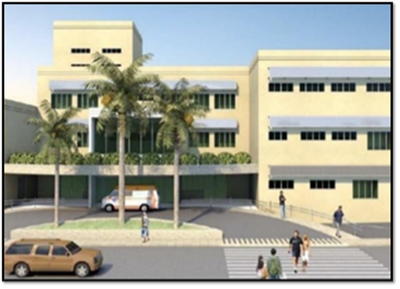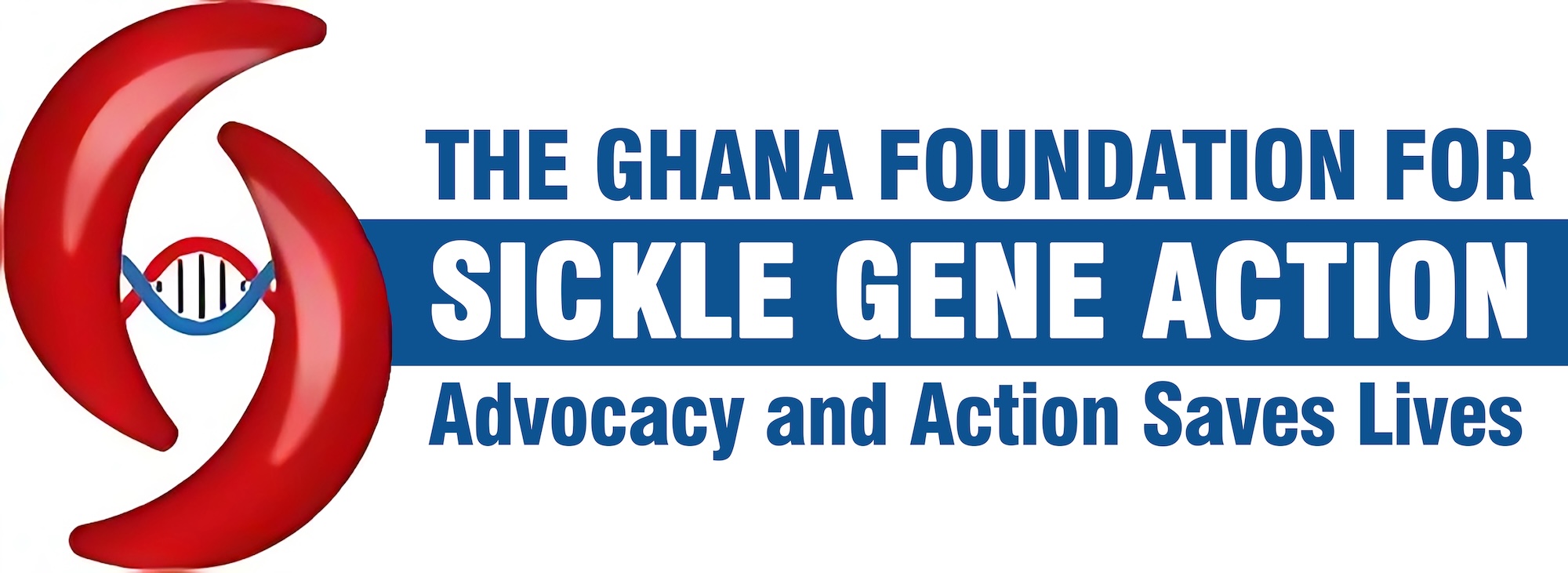6. The Kumasi Sickle Cell and Blood Centre
Ghana’s Groundwork for Providing a Center of Excellence


✓ The voices of families and patients sought: An Ashanti branch of the Sickle Cell Disease Association of Ghana was formed through the Newborn Screening for Sickle Cell Disease in Ghana” Study (1993–2008) to provide community-based support and advocacy. This association worked with the screening project team to advocate for the Center.
✓ Proposal Presented to the Ghana Ministry of Health: Professor Ohene-Frempong submitted proposals for the Center over several years, though no official response was initially received.
✓ Land allocated by Asantehene: With the support of Otumfuo Osei-Tutu II and the Komfo Anokye Teaching Hospital Board, land was allocated for the Center.
✓ Sod-cutting ceremony performed by Asantehene: On July 31, 2000, Otumfuo Osei-Tutu II performed the sod-cutting for the Center, which was also named in his honor.
✓ Institutional Structure and Support Presented: The Center was envisioned as a semi-autonomous institution under KATH, affiliated with KNUST, Ghana Health Service, the Ministry of Health, and both national and international partners.
✓ Asantehene Acknowledges the contributions to newborn screening in Ghana: In June 2001, Otumfuo Osei Tutu II visited The Children’s Hospital of Philadelphia and the University of Pennsylvania to recognize their contributions and emphasize the need for greater support for SCD programs in Africa.
✓ Asantehene announces the formation of a Sickle Cell Foundation in Ghana: During the visit, it was announced that a foundation would be established in Ghana to collaborate with one in the USA for advancing support for SCD initiatives.
✓ The Kumasi Center to be a major goal: A key initial goal of the proposed Sickle Cell Foundation of Ghana would be to establish the Otumfuo Osei Tutu II Centre for Sickle Cell Disease in Kumasi.
✓ Registered: In April 2004, the Sickle Cell Foundation of Ghana was registered as a non-profit, non-governmental organization.
✓ Announced: The Foundation’s formation was officially announced on May 10, 2004, during the Africa Day of Sickle Cell Disease, which also included the formal inauguration of the Sickle Cell Association of Ghana.
✓ Purpose: It was created to develop and support services for people living with sickle cell disease.
✓ Vision for a Sickle Cell and Blood Center: Alongside the Sickle Cell Association of Ghana, the Foundation prioritized the establishment of the Center for Sickle Cell Disease in Kumasi.
✓ Application for Support from Brazil: In 2008, the Sickle Cell Foundation of Ghana filed a request for technical cooperation with the Brazilian government under a scientific cooperation agreement, influenced by Prof. Ohene-Frempong’s collaboration with Brazilian colleagues.
✓ Agreements Signed: Brazil and Ghana signed Technical Cooperation Agreements. Brazil committed to supporting:
- The national scale-up of newborn screening
- The construction of a Blood and Sickle Cell Center in Kumasi
✓ Support from Brazil Ended: In late 2010, with a change in Brazil's leadership, further support ceased, and development plans for the Center at Komfo Anokye Teaching Hospital—originally designed by Brazil—were discontinued.
✓ GNPC Support: The Sickle Cell Foundation of Ghana (SCFG) secured sponsorship from the Ghana National Petroleum Corporation (GNPC) to fund the construction of the Center.
✓ Agreement: In 2016, GNPC signed a CSR agreement with SCFG to finance the project.
✓ Funding: GNPC contributed US$4.5 million for materials, construction, logistics, and equipment. A cheque was presented on 9th March 2016 at Manhyia Palace.
✓ Construction: Phase 1 began in 2017 and was scheduled for completion in early 2019.
✓ Location: The Center is situated at Komfo Anokye Teaching Hospital (KATH) in Kumasi.
✓ Purpose – The History: Under the leadership of Prof. Ohene-Frempong, the purpose of the Kumasi Center proposed by the Sickle Cell Foundation of Ghana has been threefold since he summarized his proposal in 2006:
✓ A Serious Chronic Condition: Sickle cell disease is a chronic debilitating disease.
✓ The Need for Comprehensive Care: Like all chronic diseases, the best health care requires long-term comprehensive management involving a multi-disciplinary team of doctors, nurses, health educators and counselors, social workers, and laboratory technicians organized to meet the multiple needs of the patients and their families.
✓ The Need for a Specialized Clinical Care Team: This team is to be available to the patient for routine outpatient services as well as acute and inpatient care.
✓ Precedents from Other Countries: Such a comprehensive approach has proven very successful in the management of SCD in many countries (U.S., U.K., France, Jamaica, Brazil, Saudi Arabia, Kuwait, and others) where there has been a well-organized approach to the management of the disease.
✓ A Need to Avoid Fragmented Care: The very large number of people with SCD in Ghana’s urban communities has made it impractical to organize their care through fragmented outpatient clinics.
✓ The Presence of an Existing Clinical Site: By 2006, the Sickle Cell Clinic at the Komfo Anokye Teaching Hospital (KATH) was serving more than 10,000 patients and had grown by more than 700 patients per year for the past five years, since the initial proposal for the Sickle Cell and Blood Center in Kumasi.
✓ The Need to Expand: Prof. Ohene-Frempong felt that a facility that is available to serve patients on a regular basis would be the ideal setting for such a large population.
✓ A Possible Medical Home for Patients in Kumasi and Surrounding Areas: The Center for Clinical Genetics at Korle Bu Teaching Hospital in Accra had been created to provide a medical home for their large numbers of patients with SCD in Accra. The proposed Kumasi Center has been under construction to serve a similar purpose for patients in Kumasi and surrounding areas.
✓ A Complex Illness: Sickle cell disease is a complex illness with multi-system involvement and a wide range of potentially fatal complications.
✓ A High Burden of Disease: Even though Africa has the highest number of patients with this disease, health care for SCD patients in Africa has lagged far behind that in countries with well-organized programs.
✓ The Need for Well-Trained Personnel: The main reason for the difference in care for patients in Africa vs. care for patients in other countries may be a lack of material resources. However, inadequately trained personnel is another contributing factor. One of the main goals of the Center for Sickle Cell Disease in Kumasi is to develop and implement national and regional training programs in the diagnosis and management of SCD.
✓ Training Goals:
▪ a. The Center aims to train doctors, nurses, laboratory technicians, counselors, and others in SCD program development as well as patient care.
▪ b. In addition, the Center is to provide education, testing, and genetic counseling related to sickle cell conditions for members of the general public.
✓ An International Genetic Disorder: Sickle cell disease is fundamentally the same disorder in all parts of the world.
✓ The Special Needs in Africa: However, the local conditions in Africa, particularly the ubiquitous influence of malaria, make the clinical manifestation of SCD different in patients who live in Africa.
✓ The Need for Africa-Centered Research: For this and other reasons, treatment options recommended in the United States and elsewhere may be inapplicable to, inappropriate, or insufficient for patients in Africa.
▪ a. Difficult economic conditions: The economic conditions in much of Africa make expensive, technologically demanding treatment regimens impractical for most patients. This includes cures and certain treatments.
▪ b. Preventable suffering and loss of life: Until an easy and inexpensive treatment or cure is found for SCD, all centers managing a large number of patients must engage in some research to improve the health and lives of the patients.
✓ The Research-Based Origin of the Center: The SCD initiative in Kumasi originated from a research grant from the National Institutes of Health of the U.S.
▪ a. The Essential Role of Research: A well-organized Center for Sickle Cell Disease in Kumasi will have research as one of its major foci of activity.
▪ b. A Strong Research Base for International Support: The Center will maintain and strengthen the links established with research institutions abroad in order to be able to compete effectively for international support for local research activities.
✓ Stalled and only 65% completed due to lack of the agreed upon funding by the GNPC.

Kumasi Center for Sickle Cell Disease
